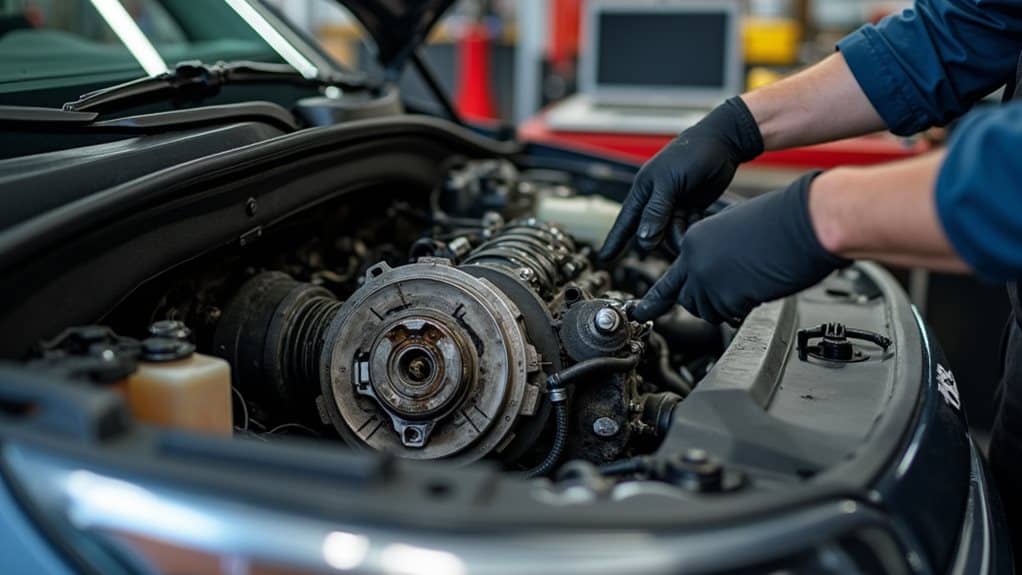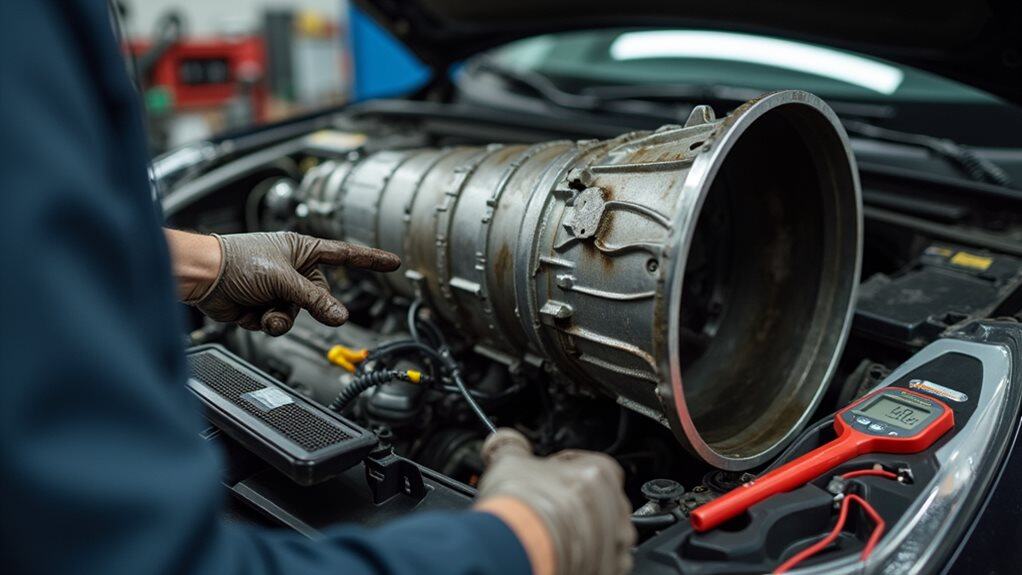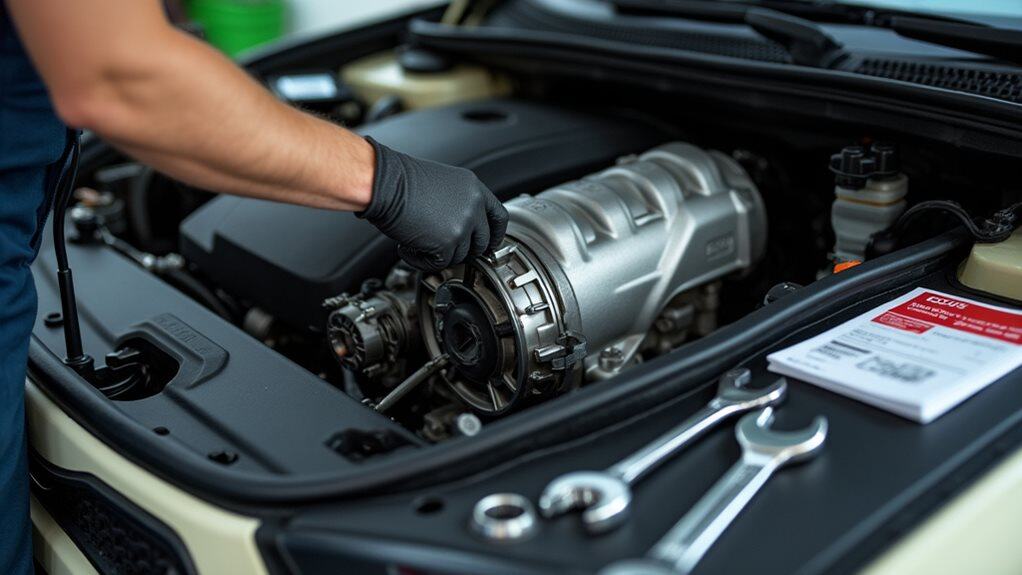Kia Soul transmissions often show whining, clunking, delayed engagement, slipping, RPM surges, or fluid leaks and warning lights; these point to worn bearings/seals, degraded or overheated fluid, contamination, or occasional design defects that reduce hydraulic pressure and cause failures. Problems are common on certain model years (notably 2012–2016 and some 2020–2021 CVTs), can create safety and resale issues, and usually need prompt diagnostics and fluid/service checks to prevent costly repairs—keep going to learn specific fixes and costs.
Quick Tips
- Kia Soul models commonly show whining, clunking, slipping, delayed engagement, or grinding indicating transmission wear or failure.
- CVT units (notably 2020–2021) and 2014–2016 models have high complaint and failure rates requiring costly repairs or replacements.
- Causes include mechanical wear, overheating, poor maintenance, fluid contamination or leaks, and occasional manufacturing defects.
- Diagnostics: listen for noises, inspect leaks, check fluid color/smell/level, and run electronic fault codes before repairs.
- Prevention and mitigation: follow service intervals, check/replace fluid and filters, avoid overheating or towing, and stop driving at first symptoms.
Common Transmission Symptoms in Kia Soul Models

Start paying attention to how your Kia Soul sounds and feels while driving, because many transmission problems announce themselves through specific symptoms you can notice early.
You’ll hear whining, clunking, or grinding during shifts or acceleration; buzzing or humming can mean wear.
Check for red or brown leaks, burnt-smelling or dark fluid, delayed engagement, slipping, jerks, RPM surges, and warning lights.
Models from certain years have higher reported failure rates, especially 2020 and 2012.
Also inspect related electrical components and battery condition, since issues like a weak battery voltage can contribute to erratic transmission behavior.
Which Model Years Are Most Affected
After you’ve learned the common symptoms that signal transmission trouble, the next step is to know which model years show the highest rates of failure so you can make informed buying or inspection decisions.
You should watch 2012–2013 for early clunks and high complaint counts, 2014–2016 for continued slippage and delayed shifts, and 2020–2021 for widespread CVT failures and recalls.
The data show that several model years between 2012 and 2016 recorded unusually high complaint volumes and costly engine repairs, so pay special attention to service records and oil consumption on those cars, especially the 2014–2016 models.
Also inspect maintenance history closely, because low oil pressure and neglected oil changes can contribute to transmission and related engine issues.
Root Causes Behind Transmission Failures

While multiple factors can lead to a Kia Soul’s transmission failure, most problems trace back to a few clear root causes you can monitor and address: mechanical wear from mileage and friction, poor or neglected maintenance that lets fluid degrade, overheating that breaks down lubricant and warps parts, manufacturing or design defects that create weak points, and contamination or fluid leaks that reduce hydraulic pressure and introduce damaging debris.
You should watch fluid condition, check for leaks, heed shifting changes, and follow service intervals to prevent bearing, clutch, and valve damage that leads to costly failures. Regular monitoring of fluid levels helps catch leaks early and avoid extensive transmission damage.
How Transmission Problems Impact Safety and Value
Because the transmission connects your engine to the wheels, problems with it directly affect both safety and resale value, so you should understand how faults translate into real-world risks and costs.
Transmission failures can cause loss of control, sudden acceleration or deceleration, stalling in traffic, fluid leaks that create hazards, and cascading drivetrain damage, all reducing reliability, buyer confidence, and market value. A related concern is that failing components can lead to fluid leaks which create safety and environmental hazards.
Diagnostic Steps Mechanics Use

Start by performing a systematic visual and auditory inspection, since many transmission faults first show as noises, leaks, or abnormal shifting behavior; you’ll listen for whining, grinding, humming, or clunking during gear changes, feel for accompanying vibrations, and look under the vehicle for fluid stains or pooled fluid.
Then check fluid level and color, drain sample for smell, use KDS to read codes, run DCT judder and solenoid tests, and perform clutch calibration sequences as needed.
Repair, Replacement, and Cost Considerations
When you’re deciding between repairing or replacing a Kia Soul transmission, weigh the specific damage, the vehicle’s age and mileage, and the estimated labor time, because those factors drive both cost and long-term reliability.
If bearings or seals are isolated, repairs (disassembly, bearing pullers, resealing, oil refill) often cost $300–$2,000; full OEM replacements run higher, $700–$1,565 parts, total replacement sometimes exceeding $3,500.
Preventive Maintenance and Owner Tips

You should check your transmission fluid regularly—visually inspect level, color, and smell during routine oil changes or at least every few months, since fresh fluid is bright and translucent while burnt or dark fluid signals trouble.
If you notice symptoms like delayed shifts, slipping, or strange noises, act promptly by scheduling a diagnostic check and avoiding heavy loads or towing until the system is assessed, because early response reduces the risk of overheating and internal damage.
Follow Kia’s recommended intervals for fluid and filter service, use the specified fluid type, and keep records of inspections and services to help technicians diagnose problems and to protect your vehicle’s longevity.
Regular Fluid Checks
Regularly checking your Kia Soul’s transmission fluid is one of the simplest preventive steps you can take to avoid costly repairs, and it gives you early warning of wear or contamination.
Check level and condition on a level surface with the engine warm, use the dipstick, note color and smell, follow Kia fluid specs, and replace if dark, burnt, or contaminated per the owner’s manual.
Prompt Symptom Response
How should you respond the moment your Kia Soul shows signs of transmission trouble? Stop driving safely, note symptoms like grinding, jerking, or burnt smells, and check fluid levels for leaks; if warning lights or refusal to shift occur, schedule a diagnostic with a transmission specialist immediately.
Follow maintenance: replace filters 30–50k miles, inspect control modules, cooling systems, and keep detailed service records.
Wrapping Up
You should monitor your Kia Soul for slipping, harsh shifts, delayed engagement, or warning lights, and address issues promptly to avoid safety risks and higher repair costs. Model years with known failures—particularly early 2010s Souls—often need transmission inspection, as wear, fluid neglect, software faults, or torque converter problems can be causes. A mechanic will run scans, fluid tests, and road checks to diagnose; repairs range from clutch packs to full replacements, so budget accordingly and follow maintenance schedules.

